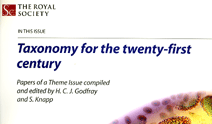“Taxonomy for the twenty-first century” and “DNA barcoding of life”: special theme issues of Philosophical Transactions of the Royal Society available online

“Taxonomy for the twenty-first century” the 29 April 2004 special theme issue of Philosophical Transactions of the Royal Society Biological Sciences is available online. Allen Herre recommends this compilation as “an extremely useful source of information and ideas on what taxonomy is, what its needs are (and our needs of it), and where it is going.”
Introduction by H. C. J. Godfray and S. Knapp
Taxonomic triage and the poverty of phylogeny by Quentin D. Wheeler
A taxonomic wish-list for community ecology by Nicholas J. Gotelli
Protist taxonomy: an ecological perspective by Bland J. Finlay
Stability or stasis in the names of organisms: the evolving codes of nomenclature by Sandra Knapp, Gerardo Lamas, Eimear Nic Lughadha, et al.
Prokaryote diversity and taxonomy: current status and future challenges by Aharon Oren
Taxonomy and fossils: a critical appraisal by Peter L. Forey, Richard A. Fortey, Paul Kenrick, et al.
Automated species identification: why not? by Kevin J. Gaston and Mark A. O’Neill
The promise of a DNA taxonomy by Mark L. Blaxter
Towards a working list of all known plant species by Eimear Nic Lughadha
Biodiversity informatics: managing and applying primary biodiversity data by Jorge Soberón and Townsend Peterson
Unitary or unified taxonomy? by Malcolm J. Scoble
The role of taxonomy in species conservation by Georgina M. Mace
Taxonomy and environmental policy by Cristián Samper
Taxonomy: where are we now? by Peter H. Raven
Now is the time: by Daniel H. Janzen
Tomorrow’s taxonomy: collecting new species in the field will remain the rate-limiting step by Robert M. May
Documenting plant diversity: unfinished business by Peter R. Crane
Taxonomy as a fundamental discipline by Edward O. Wilson
“DNA barcoding of life” the 29 October 2005 issue of Philosophical Transactions of the Royal Society Biological Sciences is devoted to papers presented at the First International Barcode Conference held at The Natural History Museum, London, 7-9 February 2005, a gathering that included 220 participants from 44 countries. By special arrangement with The Royal Society, this issue is available to members and visitors to the Consortium of the Barcode of Life site.
Towards writing the encyclopaedia of life: an introduction to DNA barcoding by Vincent Savolainen, Robyn S. Cowan, Alfried P. Vogler, et al.
DNA barcodes for biosecurity: invasive species identification by K.F. Armstrong and S.L. Ball
DNA barcoding for effective biodiversity assessment of a hyperdiverse arthropod group: the ants of Madagascar by M. Alex Smith, Brian L. Fisher, Paul D.N. Hebert
Wedding biodiversity inventory of a large and complex Lepidoptera fauna with DNA barcoding by Daniel H. Janzen, Mehrdad Hajibabaei, John M. Burns, et al.
DNA barcoding Australia’s fish species by Robert D. Ward, Tyler S. Zemlak, Bronwyn H. Innes, et al.
Deciphering amphibian diversity through DNA barcoding: chances and challenges by Miguel Vences, Meike Thomas, Ronald M. Bonett, et al.
The problems and promise of DNA barcodes for species diagnosis of primate biomaterials by Joseph G. Lorenz, Whitney E. Jackson, Jeanne C. Beck, et al.
Applying DNA barcoding to red macroalgae: a preliminary appraisal holds promise for future applications by Gary W. Saunders
Land plants and DNA barcodes: short-term and long-term goals by Mark W. Chase, Nicolas Salamin, Mike Wilkinson, et al.
Microcoding: the second step in DNA barcoding by R.C. Summerbell, C.A. Lévesque, K.A. Seifert, et al.
The unholy trinity: taxonomy, species delimitation and DNA barcoding by Rob DeSalle, Mary G. Egan, Mark Siddall
Reverse taxonomy: an approach towards determining the diversity of meiobenthic organisms based on ribosomal RNA signature sequences by Melanie Markmann and Diethard Tautz
DNA-based species delineation in tropical beetles using mitochondrial and nuclear markers by Michael T. Monaghan, Michael Balke, T. Ryan Gregory, et al.
Defining operational taxonomic units using DNA barcode data by Mark Blaxter, Jenna Mann, Tom Chapman, et al.
An integrated approach to fast and informative morphological vouchering of nematodes for applications in molecular barcoding by Paul De Ley, Irma Tandingan De Ley, Krystalynne Morris, et al.
Critical factors for assembling a high volume of DNA barcodes by Mehrdad Hajibabaei, Jeremy R. deWaard, Natalia V. Ivanova, et al.
A likelihood ratio test for species membership based on DNA sequence data by Mikhail V. Matz and Rasmus Nielsen
TaxI: a software tool for DNA barcoding using distance methods by Dirk Steinke, Miguel Vences, Walter Salzburger, et al.
This entry was posted on Thursday, April 6th, 2006 at 11:32 pm and is filed under General, Papers. You can follow any responses to this entry through the RSS 2.0 feed. Both comments and pings are currently closed.